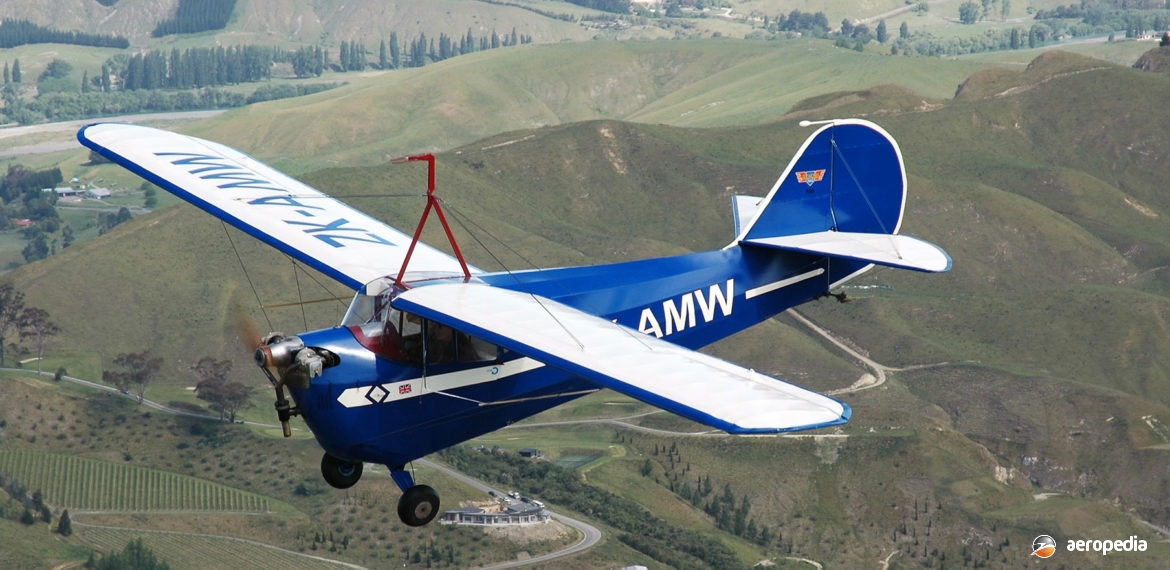Photograph:
Aeronca C-3 (100) ZK-AMW (c/n AB/105) after restoration in 2006 (K Netherclift – Claridge Aviation Prints)
Country of origin:
United States of America
Description:
Two-seat cabin monoplane
Power Plant:
One 27 kw (36 hp) Aeronca E-13C two-cylinder horizontally-opposed air-cooled engine
Specifications:
- Wingspan: 11 m (36 ft)
- Length: 6 m (20 ft)
- Height: 2.28 m (7 ft 6 in)
- Wing area: 13.19 m² (142 sq ft)
- Max speed: 129 km/h (80 mph)
- Cruising speed: 105 km/h (65 mph)
- Stalling speed: 64 km/h (40 mph)
- Initial rate of climb: 152 m/min (500 ft/min)
- Climb to 1,219 m (4,000 ft): 10 mins
- Ceiling: 4,267 m (14,000 ft)
- Range: 322 km (200 miles)
- Empty weight: 211 kg (466 lb)
- Useful load: 186 kg (409 lb)
- Loaded weight: 397 kg (875 lb)
History:
The Aeronca series was produced by the Aeronautical Corporation of America at Lunken Airport in Cincinnati, Ohio, USA. The prototype C-2 was flown for the first time in 1928 powered by the Company’s own engine, the 19.3 kw (26 hp) Aeronca E-107A two-cylinder air-cooled unit. Produced in considerable quantity, this model had a braced wing with two spruce spars and had fabric covering. The fuselage was a fabric-covered welded steel-tube structure. The C-2 Model was a single-seater.
In 1934 the two-seat Model C-3 was introduced. This was structurally similar to the previous model with the majority of production aircraft being powered by the 27 kw (36 hp) Aeronca E-113C engine, two basic models being produced, the Collegian and the Duplex. In the United States the type was regularly fitted with floats. It is believed at least 400 examples of the series was completed.
The Aeronca E-113C engine was produced under licence in the United Kingdom by J A Prestwich Ltd at Tottenham in Middlesex as the well known Aeronca JAP J-99. This differed from the original engine in producing 37 kw (50 hp) and by having dual ignition. The aircraft was also built under licence in the UK by the Aeronautical Corporation of Great Britain Ltd at Peterborough in Cambridgeshire. Twenty-one were built as the Aeronca 100. Development aircraft were also produced: one Aeronca 300, two known as the Ely 700, and one known as the Ely Type FC1, but no further production ensued.
Three examples of the Aeronca C-3 (known as the Model 100) were imported to Australia in 1936. VH-UXU (c/n AB.104) was registered to Aerial Transport Co of Sydney, NSW on 31 March 1937 and subsequent owners included Southern Airlines & Freighters, Mr W H J Colville and Mr B Thomas of Gordonvale, QLD. It was withdrawn from service in 1941.
VH-UXV (c/n AB105) was assembled at Mascot, NSW and demonstrated for a period before being damaged in an accident. It was then obtained by the Clancy brothers of Rosebery (who designed and built the Clancy Skybaby) and registered to A R Clancy of Rosebery, NSW on 4 March 1938. It was repaired and flown for a period before being sold to Mr I F McSparron of Ardlethan, NSW who flew the aircraft regularly. He later went on to become a Wing Commander with the RAAF before joining Qantas in 1944 and flew Lockheed Constellations.
At some stage this aircraft (VH-UXV) was registered to Mr E D Jones of Paddington, NSW. During World War II it was placed in storage. It was sold in Fiji in 1949 where it became VQ-FAJ and had a number of owners. The aircraft was to be taken to New Zealand in 1952 where it was allocated the registration ZK-AYW. However, it remained in Fiji and was involved in an accident in 1958. It was dismantled, shipped to New Zealand, and placed in storage awaiting restoration at Onekawa. In 2005 the restoration was completed and it became ZK-AMW on 11 April 2006, being registered as an Aeronca 100 U/L. It survives and is airworthy.
VH-UYZ (c/n AB.102) was first registered to W W Pike trading as Light Aeroplanes Pty Ltd of Brisbane, QLD on 13 January 1937. Subsequent owners included H H Simpson of Mackay, QLD, J B Newberry of Sarina, QLD, and B Thomas of Gordonvale, QLD. It was withdrawn from service in August 1940 and is not known to have survived.
A couple of examples survive in airworthy condition in the United States and Great Britain. Others are known to be under restoration.

